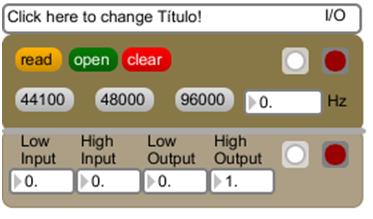As to the CSV files, as mentioned before, the system is configured such that they are read from a Data Patch, in which they are read and streamed on a bus-like behavior. So these files, which effectively are numbers, are streamed and used by any of the parameters on the main patch or at the Stream Selectors. The Data Patch is shown in the next figure.
Figure 17. Picture of a single Data Reader, with which data from CSV files is read and stored into a file and scanned on real time, outputting the numbers on it, to be read by the Stream Selectors. As seen in the picture, the rate of reading can be set in commercial values or by manual manipulation.
This patch contains 16 Data Readers, with which 16 different CSV files can be streamed. Each one of these Data Readers has a space to give it a name that will automatically be recognized by the Stream Selectors and added to the menus from where t hey can be selected to map some parameter.
The data that is coming from the CSV files can do so at different rates, set at each of the Data Readers, buttons are displayed for this purpose, so that numbers can be read with a frequency of 44100 4800 and 9600 per second. A number box is also provided to set a custom reading rate. Plus another Scaling Section is included in this Data Readers for the same purpose as the one mentioned before.
Both for the Scaling on the Data Readers and the Stream Selectors, there is a button to activate the scaling, and another button that updates the scaling values, in case the order of the parameter setting alters the functioning of the patch.
This approach again is similar to the ideas expressed by Saue on (Saue, 2000), in the analysis of Sonification display models, where it is proposed that the set of data mapped into sound be reproduced on a stream that is always running (a bus) and which speed can be modified for different purposes. This stream is then available for any part of the Sonification algorithm at any time, but as it will be always running, the mapping can start at any point of the data set.
The idea following this structure is that if one single data file is used to map several parameters on the sound creation, this is a practical and logical way of synchronizing them, acquiring the same data, from the same place, at the same time.
…
Further on this chapter:
0. CONTENT
4.2 DATA READING
4.4 STREAM SELECTORS
4.5 SCALERS
4.6 VOLUME MAKER
4.7 DATA READERS
4.8 PHYSICAL LAYER
